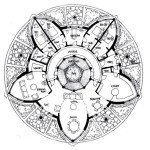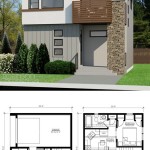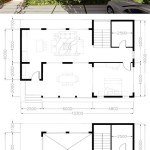Tudor House Floor Plans: A Journey Through History and Architecture
The Tudor period in English history, spanning from 1485 to 1603, witnessed a dramatic shift in architectural styles and home designs. Tudor houses, with their distinctive features and intricate floor plans, continue to captivate homeowners and architecture enthusiasts alike. This article delves into the fascinating world of Tudor house floor plans, exploring their historical context, unique characteristics, and the enduring appeal that makes them relevant even today.
Historical Context
The Tudor era marked a period of great political and social change in England. The rise of the Tudor dynasty, the dissolution of monasteries, and the Protestant Reformation all contributed to a transformation of the English landscape and lifestyle. These changes were reflected in the architecture of the time, as people began to build homes that reflected their newfound wealth and status.
Tudor houses were typically built by wealthy merchants, nobles, and gentry. These homes were designed to be both comfortable and impressive, showcasing the owner's wealth and social standing. The floor plans of these houses often featured large, open spaces for entertaining guests, as well as private chambers for the family and their servants.
Unique Characteristics of Tudor House Floor Plans
Tudor house floor plans are characterized by a number of distinct features, including:
- L-shaped or H-shaped layout: Tudor houses were often built in an L-shaped or H-shaped configuration, with the main entrance located at the intersection of the two wings. This layout allowed for a more private and sheltered courtyard, as well as a more efficient use of space.
- Great hall: The great hall was the central room in the Tudor house, where the family and their guests would gather for meals, entertainment, and socializing. The great hall was typically located on the ground floor and was often open to the roof, creating a sense of spaciousness and grandeur.
- Private chambers: The private chambers of the family were typically located on the upper floors of the house. These rooms were smaller and more intimate than the great hall and were used for sleeping, dressing, and studying.
- Staircase: The staircase in a Tudor house was often located in a prominent position, such as the center of the great hall. The staircase was typically made of wood and was often elaborately carved.
- Windows: Tudor houses had large, mullioned windows that allowed for plenty of natural light. The windows were often decorated with stained glass, which added color and interest to the interior of the house.
Enduring Appeal of Tudor House Floor Plans
Tudor house floor plans have stood the test of time and continue to be popular with homeowners today. There are a number of reasons for this enduring appeal:
- Historical charm: Tudor houses have a timeless charm that evokes a sense of history and tradition. The unique architectural features of these homes, such as the great hall and the mullioned windows, create a sense of grandeur and elegance.
- Practicality: Tudor house floor plans are very practical, with a clear separation between public and private spaces. The large, open spaces of the great hall and the private chambers of the family provide plenty of room for both entertaining guests and enjoying family life.
- Flexibility: Tudor house floor plans are also very flexible, allowing homeowners to adapt the space to their own needs and preferences. The large, open spaces of the great hall can be used for a variety of purposes, from entertaining guests to hosting family gatherings. The private chambers can be used for bedrooms, studies, or even home offices.
Tudor house floor plans offer a unique blend of historical charm, practicality, and flexibility. These homes are a testament to the enduring power of good design and continue to inspire homeowners and architects alike.
Examples of Tudor House Floor Plans
There are many examples of Tudor house floor plans that can be found throughout England. Some of the most famous examples include:
- Hardwick Hall, Derbyshire: Hardwick Hall is a magnificent Tudor mansion that was built in the 16th century. The house has a U-shaped layout and features a great hall that is over 100 feet long. Hardwick Hall is a popular tourist destination and is open to the public.
- Hatfield House, Hertfordshire: Hatfield House is another impressive Tudor mansion that was built in the 16th century. The house has an H-shaped layout and features a great hall that is over 60 feet long. Hatfield House is the home of the Marquess of Salisbury and is open to the public on certain days of the week.
- Baddesley Clinton, Warwickshire: Baddesley Clinton is a beautiful Tudor manor house that was built in the 16th century. The house has an L-shaped layout and features a great hall that is over 40 feet long. Baddesley Clinton is open to the public and is a popular wedding venue.
Conclusion
Tudor house floor plans are a testament to the enduring power of good design. These homes, with their distinctive features and intricate layouts, continue to captivate homeowners and architecture enthusiasts alike. Whether you are interested in history, architecture, or simply beautiful homes, Tudor house floor plans are sure to leave a lasting impression.

Tudor House Plans Old English Floor

Tudor Style House Plans For A Gorgeous Four Bedroom Home

House Plan 90348 Tudor Style With 2088 Sq Ft 3 Bed 2 Bath 1

Seattle Homes Tudor Style House Plan Design No 132 1908 Western Home Builder Victor W Voorhees

English Country Style Tudor House Plans With 4 Bedrooms

This Is So Perfect Super Attractive Has A Library Though I Probably Won T Be Needing The Servant Tudor House Plans Vintage Cottage

7 Bedrm 15079 Sq Ft Tudor House Plan 195 1012

33 Best Tudor House Plans Ideas

Tudor House Style A Free Ez Architect Floor Plan For Windows

House Plan 89413 Tudor Style With 4386 Sq Ft 4 Bed Bath 1








